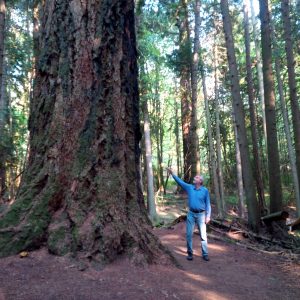What’s in a name?

In March, mature coastal Douglas-firs are 12 months into their 17-month reproductive cycle. March is the time of pollen making, and in April the pollen-bearing cones burst and pollination of the seed cones begins.
Pseudotsuga menziesii was first discovered on Vancouver Island in 1791 by Archibald Menzies; its common name honours David Douglas, who introduced the tree into cultivation. The surnames of these intrepid Scottish botanists grace the scientific names of numerous species—menziesii and douglasii.
Like many plants, though, Pseudotsuga menziesii has not always been so named. As Dr. Matt Ritter writes, “Douglas-fir has changed scientific names nearly twenty times since its discovery by Europeans, from Pinus taxifolia, through Abies douglasii, eventually settling on Pseudotsuga menziesii….” But why? any reasonable non-botanist might ask.
In his article, “Why Plant Names Change,” Dr. Ritter offers an insider’s look at how plant names can morph, often rattling the nerves of plant growers, gardeners, botanists, and, undoubtedly, botanical editors tasked with updating databases and taming cross-references.
E-Flora BC, an online atlas of flora in British Columbia, tussles with renaming, as do many other electronic plant resources. If you happen to be editing botanical text, it’s worth checking with your author about plant names that may have changed, in case older appellations are hiding in the copy.
And it’s not just plant names that change. The venerable International Code of Botanical Nomenclature, the rule book governing plant naming, revised its title in 2011. It is now the International Code of Nomenclature for algae, fungi, and plants, or the Melbourne Code for short. (You can plumb the depths of its preface to learn why.)
If all this talk about nomenclature and taxonomy has your head spinning, consider unwinding by doing some creative nature naming yourself. “Astrifuges,” anyone?



